The students also were very excited about a math activity we did this week called Diffy Squares (Difference Squares). The students all drew a large square on their paper and labeled the 4 corners with numbers. They then have to find the difference between the 2 corners and put it in the middle of that line segment, eventually making a new square with the differences between numbers on all 4 sides of the square. Their goal is to get all 4 sides to equal 0, but to do this in as many steps are possible. Below you can see 2 Diffy Squares. The first one needed only 4 steps to get to 0, while the second one had 6 steps. Two students completed 8 step Diffy Squares, so they are all trying to beat that.
The students thought they were fun and interesting (and I thought they were a great way to practice subtraction!). Here are some pictures of the students hard at work on their Diffy Squares.

















































